Choosing the right Shoes For Salsa Dance is crucial for comfort, performance, and style on the dance floor. Whether you’re a beginner taking your first steps or a seasoned pro, your footwear can significantly impact your salsa experience. After eight years immersed in the world of salsa and bachata, and countless hours searching for the perfect dance shoe, I’m here to share my insights and help you find the best shoes to elevate your salsa game.
Like many, my salsa journey began with a struggle to keep up with the footwork. It was in a small, vibrant dance studio in Medellin, Colombia, surrounded by infectious music and passionate dancers, that I truly fell in love with salsa. Since then, my passion has only grown, leading me to dance floors across the US and Asia. Along the way, I’ve developed a particular fascination – perhaps even an obsession – with men’s salsa dance shoes. While it might elicit a few eye-rolls from friends, I believe the right footwear is essential for any serious dancer.
This guide is for those who, like me, are on the hunt for the ultimate salsa dance shoe. We’ll explore what makes a shoe excel in style, performance, comfort, and versatility, addressing the key questions every salsa dancer considers:
Style: Which shoes look great on the dance floor and beyond?
Performance: What footwear can actually enhance your salsa technique and movement?
Comfort: Which shoes can keep your feet happy and pain-free through hours of dancing?
Versatility: Are there shoes that can transition seamlessly from the dance floor to everyday life, eliminating the need for extra baggage?
As a former athlete with a history of demanding physical activity, I understand the importance of proper equipment. Just as the right gear is vital in sports, the correct shoes can make all the difference in salsa. Let’s dive into the world of salsa shoes and discover your perfect pair.
Decoding the Footwear of Salsa Professionals
To begin my quest for the ideal salsa shoe, I turned to the experts: professional salsa dancers. Observing what the pros wear offers valuable clues about what works best in terms of performance and style. Here’s a look at some notable dancers and their footwear choices:
Ataca and El Tiguere: These bachata icons are renowned for their captivating style and technique. They often favor eye-catching, shiny loafers, previously Jose Bottas and currently Taygras. Their choice reflects a bold and confident style, although perhaps not for the faint of heart in everyday social dancing.
Daniel: Famous for his sensual bachata style with Desiree, Daniel often opts for what appear to be jazz shoes. Occasionally, he’s seen in running shoes or cross-trainers, prioritizing comfort and flexibility.
Rodolfo Montano Castro: This dancer’s incredible footwork and rhythmic precision are mesmerizing. He frequently dances in well-worn sneakers with thin soles. For Dominican-style bachata, a bit of grip is acceptable as there’s less turning involved compared to salsa. Observing dancers in Joan Soriano’s music videos further confirms the prevalence of sneakers or even sandals in more casual Dominican dance settings.
Terry: An incredibly dynamic and energetic dancer, Terry sometimes dances barefoot, possibly with tape for protection, or even in Birkenstocks for casual comfort. In more formal settings, he appears in Latin or jazz shoes. His example underscores that exceptional dance ability transcends footwear – a great dancer can shine even with minimal shoes, much like a skilled musician can create magic with any instrument. I was fortunate to witness Terry and Cecile dancing improvisationally under the moonlight at a festival in Vietnam – a testament to their artistry and connection, regardless of the dance floor or footwear.
Adolpho Indochea: A world salsa champion and a significant influence on my own Colombian salsa teachers, Adolpho is known for his precise and stylish dancing. He typically favors traditional Latin dance shoes, reflecting a classic and formal approach to salsa.
Insights from Salsa Teachers and Top Dancers: My instructors in Colombia often recommended dance sneakers for their comfort and ability to facilitate dancing on the balls of the feet and smooth spins. However, observing top social dancers reveals a diverse range of footwear, including sneakers, loafers, and running shoes. Jazz shoes and Latin dance shoes are less common in social settings, suggesting a preference for comfort and versatility over specialized performance footwear for many male salsa dancers.
Common Traits of Great Salsa and Bachata Shoes:
Based on observing professional and experienced dancers, several key characteristics emerge for ideal salsa and bachata shoes:
- Lightweight: Minimizing weight enhances agility and reduces fatigue.
- Snug Fit: A close fit provides better control and responsiveness, avoiding a clunky feel.
- Thin Sole: A thin sole allows for better ground feel and connection to the dance floor.
- Flexible Sole: Flexibility mimics the natural movement of the foot, crucial for intricate footwork.
- Stylish: Whether understated or bold, the shoe should reflect the dancer’s personal style and attitude.
- Comfortable: Essential for enduring long practice sessions and social dance nights.
A Detailed Review of Men’s Salsa Shoe Options
Now, let’s delve into a detailed review of various types of shoes commonly used for salsa dancing, weighing their pros and cons:
1. Salsa Sneakers – Dance Sneakers
Recommended by my first dance studio, DanceFree in Medellin, dance sneakers are designed specifically for dance practice and performance. They combine the lightweight and durable nature of athletic sneakers with a split sole – separating the ball and heel of the foot. The smooth outsole enables easy spinning, and the split sole enhances flexibility, encouraging dancing on the balls of your feet.
While excellent for practice and casual social dancing, dance sneakers aren’t always ideal for everyday wear. Their sporty aesthetic may not suit all social settings, and the split sole can feel unusual when walking normally.
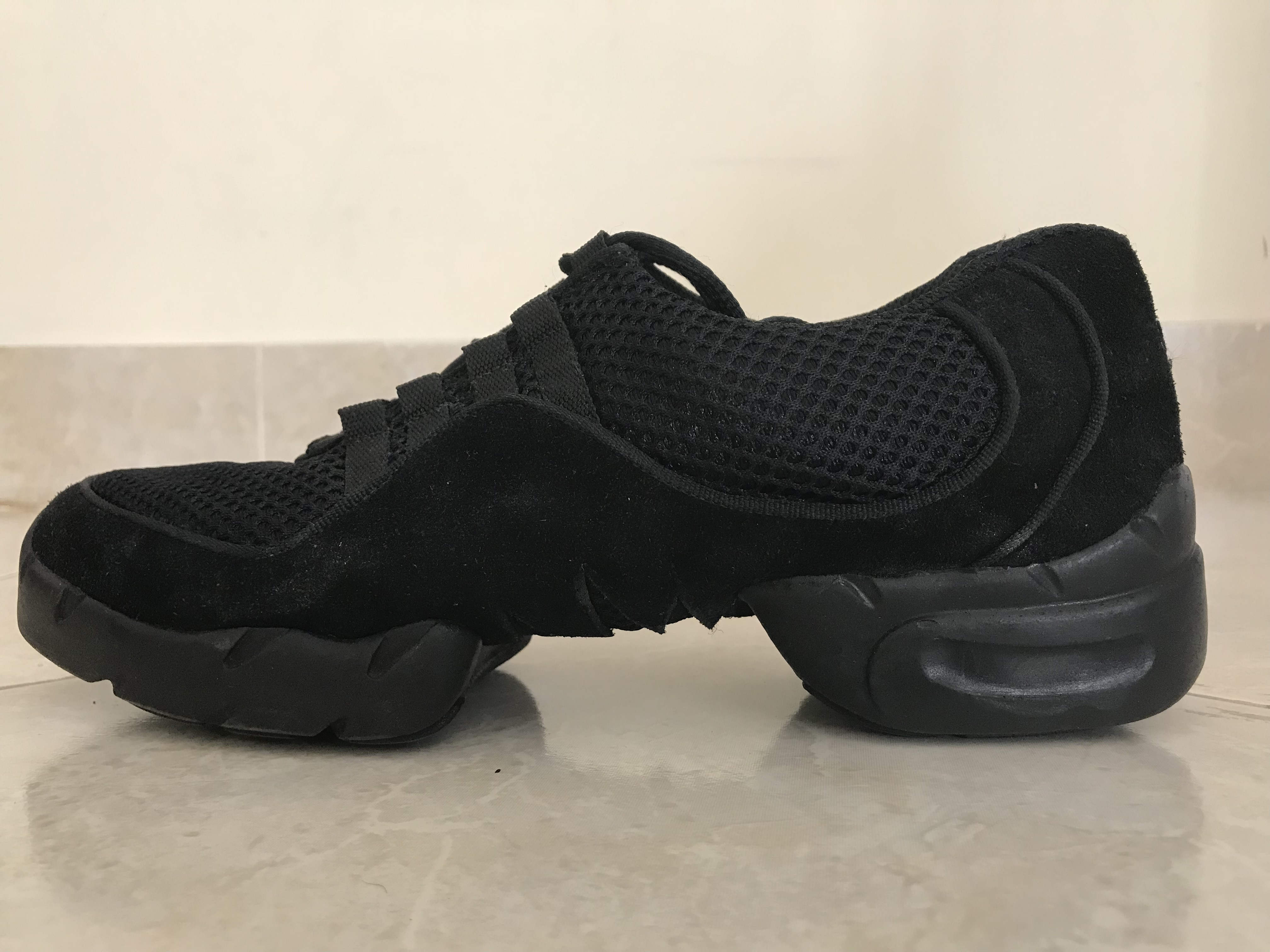 Men’s Dance Sneaker Profile
Men’s Dance Sneaker Profile
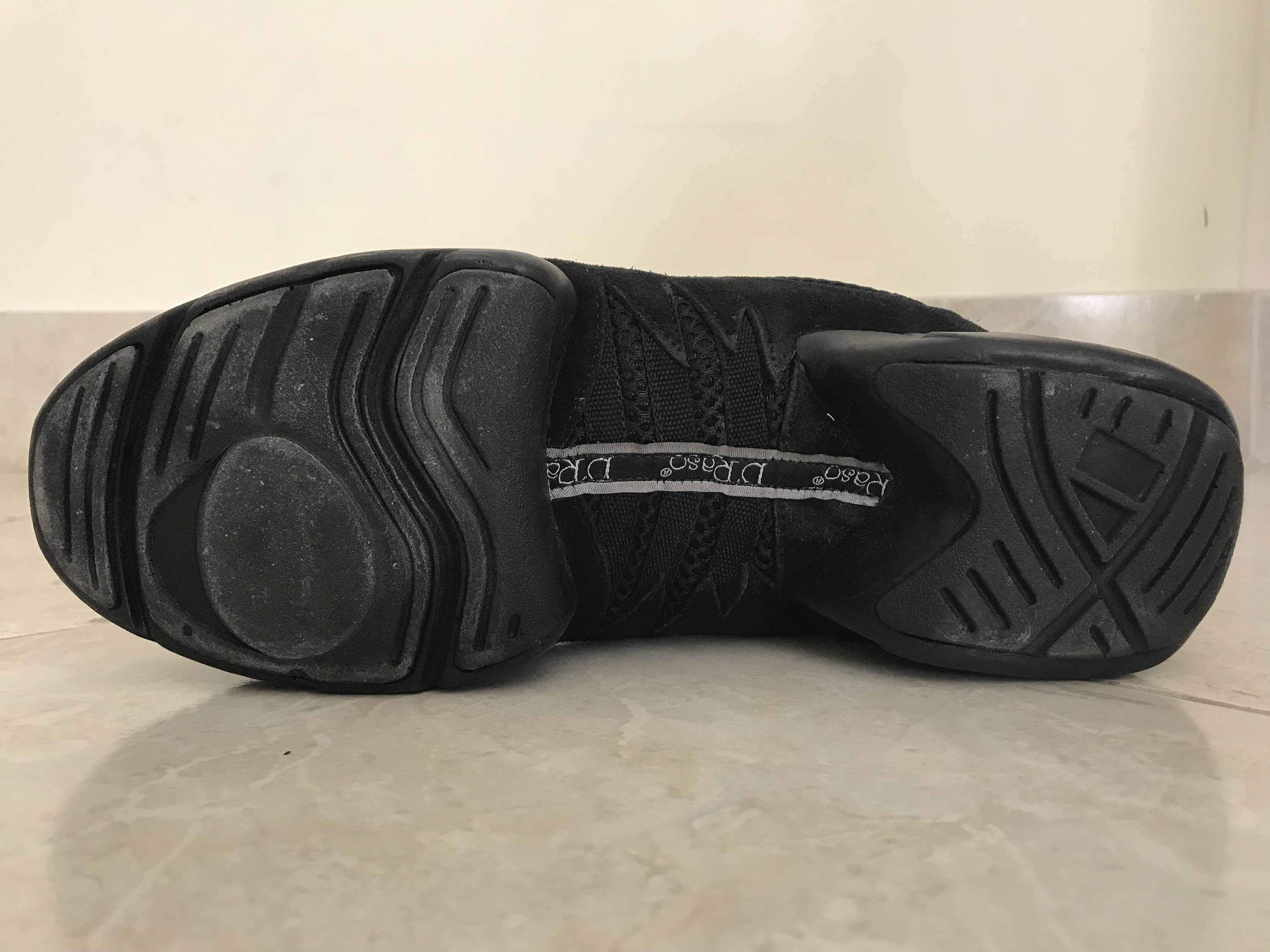 Men’s Dance Sneaker Sole
Men’s Dance Sneaker Sole
Pros:
- Lightweight and flexible
- Split sole encourages proper footwork
- Smooth sole for easy spins
- Durable for practice
Cons:
- Not versatile for everyday wear
- Split sole can feel strange for walking
- Sporty look may not be suitable for all occasions
Cost: $50-70 USD
2. Latin Dance Shoes (with Heels)
Experiencing Latin dance shoes gave me a newfound appreciation for what female dancers endure! Purchased during my time in Taiwan, these shoes are undeniably dressy and feature suede soles, making spins effortless and shines sharper. Instructors often recommend the Latin heel for improved dance posture and form. Wearing them makes a clear statement of serious dedication to dance.
However, Latin dance shoes are not designed for comfort over extended periods. The pointed toe box can feel constricting, and the heel, while beneficial for posture, adds strain. They are strictly dance shoes, unsuitable for wearing outside the dance floor. Best reserved for performances or shorter social dance sessions.
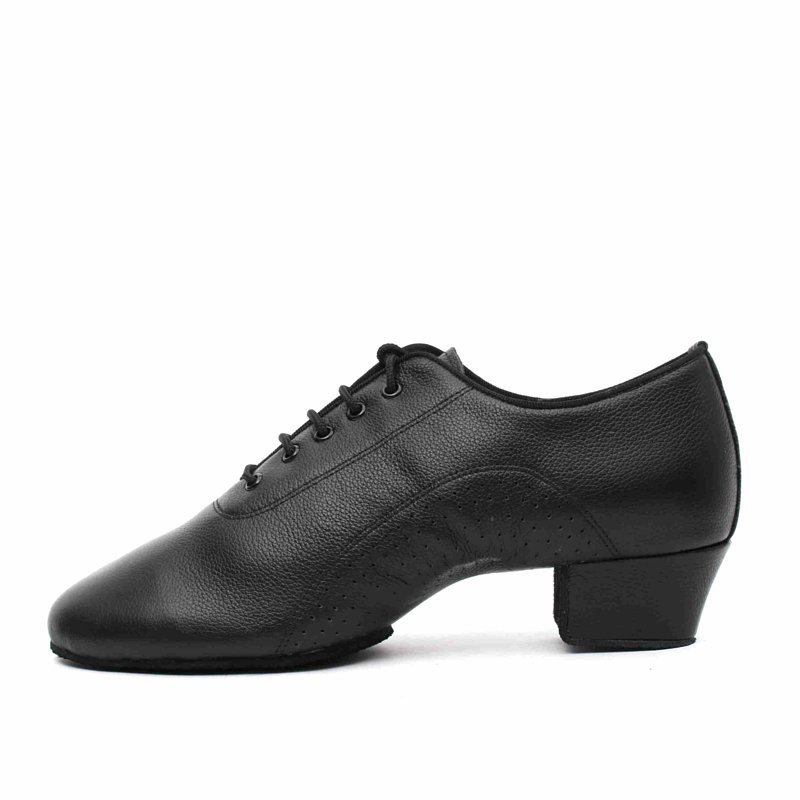 Men’s Latin Dance Shoe Profile
Men’s Latin Dance Shoe Profile
Pros:
- Dressy and stylish for formal dance events
- Suede soles for exceptional spin and slide
- Heel promotes better dance posture
Cons:
- Uncomfortable for prolonged wear
- Not versatile for everyday use
- Suede soles are delicate and not suitable for outdoor surfaces
Cost: $60-70 USD
3. Jazz Shoes
Jazz shoes were a revelation, introduced to me by an instructor who favored jazz boots. Lightweight, inexpensive, and feeling almost like dance socks, jazz shoes are exceptional practice footwear. Split-sole jazz shoes offer a near-barefoot feel, enhancing freedom for shines, spins, and Dominican bachata movements.
The major drawback is their lack of practicality outside the studio. Suede soles are easily damaged and unsuitable for outdoor wear or wet conditions.
Pros:
- Extremely lightweight and flexible
- Closest feel to dancing barefoot
- Excellent for spins and footwork practice
- Affordable
Cons:
- Not durable for outdoor use
- Suede soles are delicate
- Not versatile for everyday wear
Cost: $20-30 USD
4. Running Shoes
Running shoes prioritize comfort, support, and durability. They are suitable for all-day wear and provide ample cushioning. During my first six months of salsa, Nike Pegasus running shoes were my go-to. However, their high-grip soles make spinning challenging and potentially risky for ankles and knees. The thick, cushioned soles also reduce ground feel, and some models can be bulky.
Pros:
- Highly comfortable and supportive
- Durable for everyday wear and dance practice
- Suitable for long hours of wear
Cons:
- High-grip soles hinder spinning
- Thick soles reduce ground feel
- Can be bulky
Cost: $60-140 USD (Nike | Asics)
5. Sneakers
Sneakers are my preferred choice for social salsa dancing. They offer a blend of lightweight comfort, a snug fit similar to dance shoes, and street style versatility. Many sneakers feature smooth synthetic soles ideal for spinning on various dance floor surfaces. While heavier-soled sneakers like Converse can be tiring, thinner-soled options provide better dance feel. I discovered a Vietnamese brand at an affordable price point that proved to be a great, albeit less durable, option.
The downside is limited support and often sticky rubber soles, stemming from their athletic origins in skateboarding, tennis, or basketball. They are also casual shoes, less appropriate for formal events. Toms are often recommended by dancers for their lightweight and spin-friendly nature. My research led me to Taygras, a Brazilian brand originally for soccer and capoeira, now popular for dance. Their flexible soles offer excellent floor feel and a casual, everyday aesthetic, making them a promising option for practice and social dancing.
Pros:
- Versatile style for dance and everyday wear
- Lightweight and comfortable
- Many models have smooth soles for spinning
Cons:
- Can lack support
- Rubber soles can be sticky
- Casual style not suitable for formal events
Cost: $20-80 USD (Toms | Taygras)
6. Formal Dress Shoes
My search for danceable formal dress shoes has been extensive. The ideal dress shoe would eliminate the need for a separate pair for work and dance, offering stylish comfort throughout the day and night. However, most dress shoes are stiff, heavy, and restrictive for dancing. Dressier styles often equate to stiffer soles. While some have leather or suede bottoms for easier spinning, they often lack comfort for extended dance sessions, and stiff ankle areas can cause discomfort.
After trying several dress shoe styles, leather moccasins with flexible outsoles have been the closest to a danceable dress shoe. Brands like GFranco and Jose Botta, popular among Latin dancers, offer dressy loafers that balance formal style and dance function. Jose Botta shoes, designed for both work and play, are particularly appealing.
Pros:
- Formal style suitable for dressier occasions
- Eliminates need for extra shoes
- Some models offer leather or suede soles for spinning
Cons:
- Often stiff and uncomfortable for dancing
- Can be heavy and restrictive
- Not always designed for dance movement
Cost: $40-140 USD (Jose Botta)
And the Top Picks Are…
For Practice: Jazz Shoes. For home practice or studio sessions on smooth floors, jazz shoes are the most economical and effective choice. At $20-30, they offer excellent value and dance feel. The only inconvenience is needing to bring them along. If portability is a concern, running shoes or sneakers are alternatives, though less ideal for spin-heavy practice.
For Social Dancing: Sneakers. Sneakers offer the best overall versatility. They look stylish in various social settings, before, during, and after dancing, eliminating the need for extra shoes. While they might not maximize spin performance or showcase intricate footwork as effectively as specialized dance shoes, they are a reliable and comfortable choice for social salsa. Running shoes with smooth outsoles can serve as a comfortable backup option.
For Formal Dance Nights: Dress Shoes. Well-fitting and broken-in dress shoes are the most appropriate for formal dance events. Latin dance shoes are another option but require bringing an extra pair. Your existing dress shoes with leather bottoms might already be suitable.
DIY Dance Shoe Wisdom
Hot Tip: Understand Your Dance Floor. After initially embracing jazz shoes for social dancing, I quickly learned that suede soles aren’t universally effective. They performed poorly on two out of three regular dance venues. The dance floor surface is as critical as your shoe choice. Before investing in salsa shoes, observe what experienced dancers wear at your usual venues.
In terms of outsole versatility, synthetic materials are generally the most adaptable, followed by leather, suede, and rubber. Smooth synthetic outsoles work well on wood, ceramic, vinyl, linoleum, and even carpet.
Recommended Salsa Shoe Brands for Men
My friend, a Bachata Champion of Vietnam, recommends Toms for their blend of versatility and dance performance. I intend to try a pair soon.
I am particularly enthusiastic about my Taygras! Their stylish design and dancer-focused flexible, smooth sole are highly appealing. Furthermore, their commitment to ethical and sustainable practices* resonates with me.
*Did you know that 20 billion shoes are produced annually, with 90% ending up unrecycled? The leather industry has significant negative impacts on animals, workers, and the environment. I prioritize shoes that are durable, minimize harm, and are recyclable. Taygras utilizes 100% recyclable materials.
Jose Botta also recognized this issue and designed excellent dance shoes. Endorsed by Ataca and El Tiguere, Jose Botta shoes are praised for their functionality and performance. While pricier, they are on my radar for when my dance skills warrant them!
GFranco offers sleek dance shoes, but like Jose Botta, they are in a higher price range and explicitly designed for dance performance rather than everyday wear. I plan to explore them further and share my findings.
My Salsa Shoe Wishlist After Years of Dancing
After years of searching, my ideal salsa and bachata shoe would have these features:
- Stylish and Versatile: Easy to pair with various outfits.
- Lightweight: Minimizes effort and enhances footwork agility.
- Foot-Hugging Fit: Snug and responsive, avoiding a bulky feel.
- Thin Sole: Maximizes ground feel and quick responsiveness.
- Ball-of-Foot Focus: Encourages proper salsa dance posture.
- Cushioned and Flexible: Provides energy return and comfort.
- Smooth Outsole: Enables easy spinning on diverse surfaces.
- Versatile Outsole Material: Suitable for indoor and outdoor wear in different weather.
- Dual-Purpose: Suitable for both work and dance.
Has anyone discovered this holy grail of salsa shoes? What are your favorite shoes for salsa and bachata? Share your recommendations in the comments below – your insights will help continue this exciting quest!

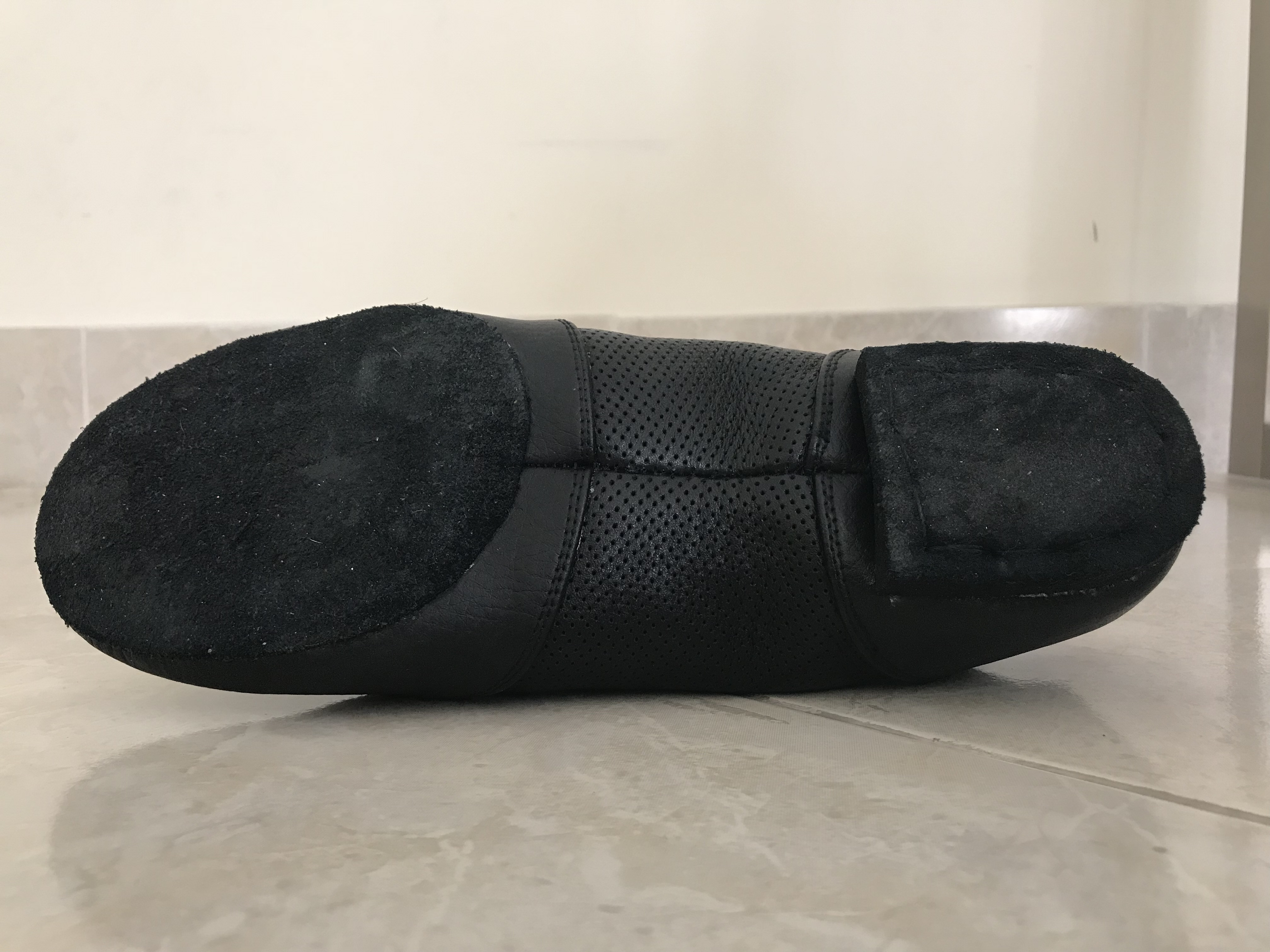 Men’s Jazz Shoe Sole
Men’s Jazz Shoe Sole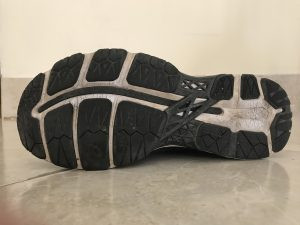 Running Shoe Sole
Running Shoe Sole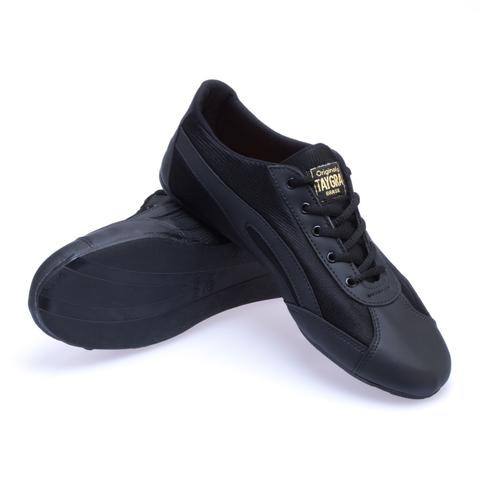 Taygras Sneakers
Taygras Sneakers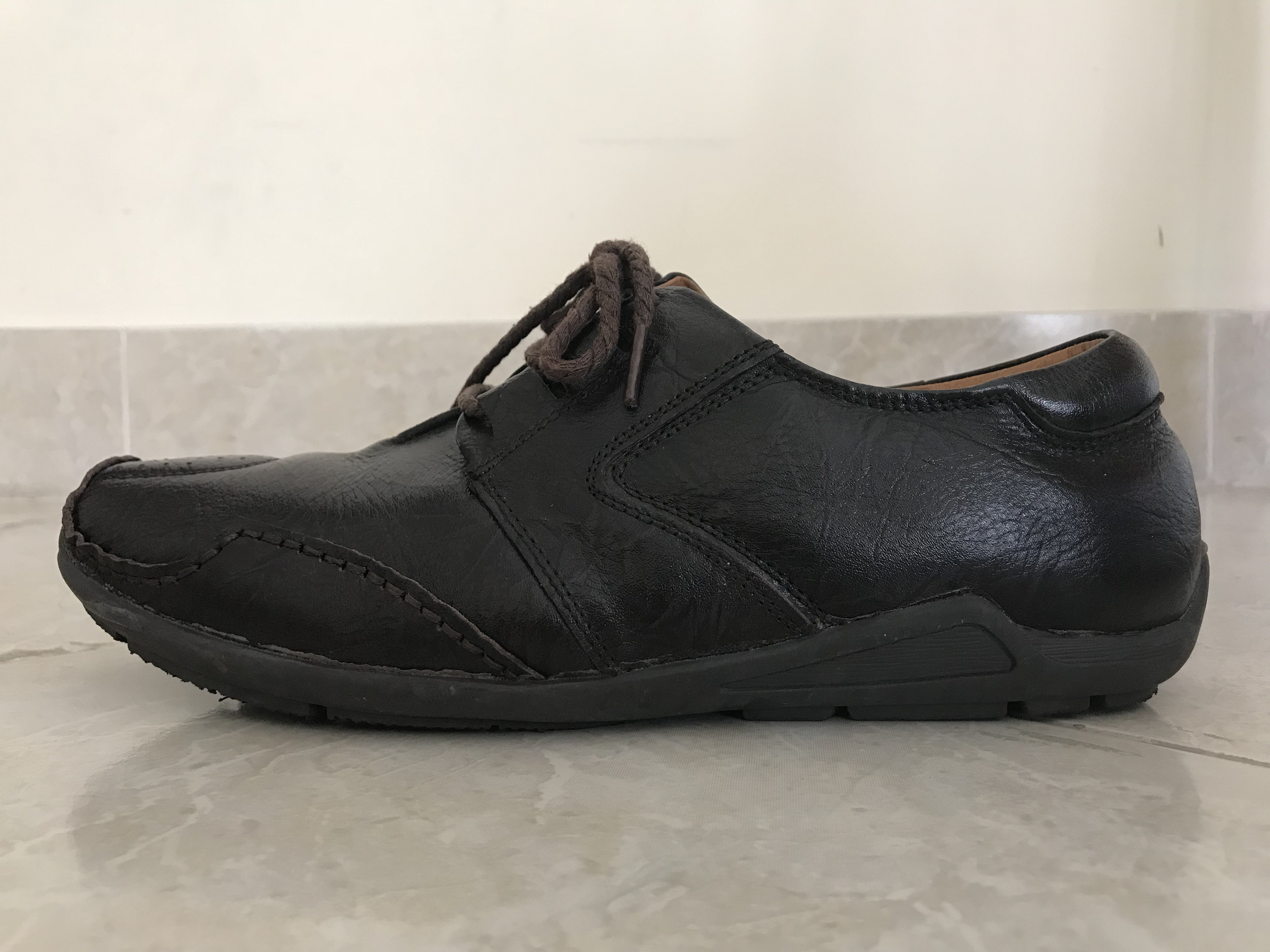 Leather Moccasin Profile
Leather Moccasin Profile